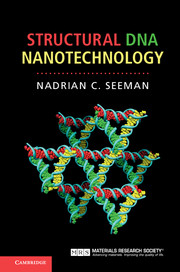Book contents
- Frontmatter
- Contents
- Preface
- 1 The origin of structural DNA nanotechnology
- 2 The design of DNA sequences for branched systems
- 3 Motif design based on reciprocal exchange
- 4 Single-stranded DNA topology and motif design
- 5 Experimental techniques
- 6 A short historical interlude: the search for robust DNA motifs
- 7 Combining DNA motifs into larger multi-component constructs
- 8 DNA nanomechanical devices
- 9 DNA origami and DNA bricks
- 10 Combining structure and motion
- 11 Self-replicating systems
- 12 Computing with DNA
- 13 Not just plain vanilla DNA nanotechnology: other pairings, other backbones
- 14 DNA nanotechnology organizing other materials
- Afterword
- Index
- References
10 - Combining structure and motion
Published online by Cambridge University Press: 05 December 2015
- Frontmatter
- Contents
- Preface
- 1 The origin of structural DNA nanotechnology
- 2 The design of DNA sequences for branched systems
- 3 Motif design based on reciprocal exchange
- 4 Single-stranded DNA topology and motif design
- 5 Experimental techniques
- 6 A short historical interlude: the search for robust DNA motifs
- 7 Combining DNA motifs into larger multi-component constructs
- 8 DNA nanomechanical devices
- 9 DNA origami and DNA bricks
- 10 Combining structure and motion
- 11 Self-replicating systems
- 12 Computing with DNA
- 13 Not just plain vanilla DNA nanotechnology: other pairings, other backbones
- 14 DNA nanotechnology organizing other materials
- Afterword
- Index
- References
Summary
Most of this book has been devoted to structure, although in Chapter 8 we talked about DNA-based nanomechanical devices. It is a natural thing to wish to combine devices with structures, so that one can place the devices and get them to work in a specific structural context. To be sure that the motion is occurring in the device whose state is being varied, as opposed to some other devices that might be in solution, direct structural observation of the device, or an array of devices, is desirable. Therefore, it is necessary is to have a structure large enough to accommodate both a machine and the attachments necessary to demonstrate the motion.
Combinations before origami. The first attempt at doing this was in the era before DNA origami. Thus, the way to provide a structural context for a nanomechanical device was a 2D array. We saw in Chapter 7 that a TX array can be connected 1–3 to its neighbors (see Figure 7-8), thereby generating a gap that provides a little space for accommodating the attachments. This space provides an attachment point where a nanomechanical device can be placed. The PX-JX2 device was used in the first example below. This device was converted to a cassette that could be fitted into the slot by the addition of an extra helix. The cassette consists of the PX-JX2 device with another domain added to it on one end, as shown in Figure 10-1. Panel a shows the cassette in the PX state in a frontal view. A third helical domain is visible on the lower left. Panel c shows the same cassette in the JX2 state. You should note that the PX device is formed with crossovers between strands of the same polarity, but the cassette has been added by fusing strands of the opposite polarity. So as to visualize the motion of the device in the context of the array, it was necessary to add a hairpin marker, which appears as a circular magenta helix with yellow base pairs viewed down its axis. It is in front of the cassette device in panel a, and behind it in panel c. The cassette is shown obliquely in panels b and d, where the hairpin is more readily visible.
- Type
- Chapter
- Information
- Structural DNA Nanotechnology , pp. 172 - 185Publisher: Cambridge University PressPrint publication year: 2016



